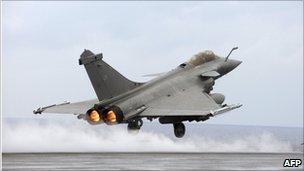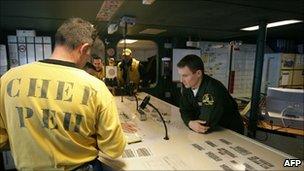On board the pride of the French navy
- Published
Louis, one of the pilots, gave an insight into one of his sorties
The French aircraft carrier Charles de Gaulle is operating off the Libyan coast as part of the Nato operation against Colonel Muammar Gaddafi's regime. The BBC got exclusive access on board the pride of the French navy.
It is the aircraft carrier Britain no longer has.
The Charles de Gaulle is not just the French Navy's flagship. It is a projection of the nation's power that can be deployed almost anywhere in the world.
We joined the nuclear powered carrier off Libya's coast. This is where the Charles de Gaulle has been conducting military operations for the past two months.
Launching an endless stream of warplanes loaded with bombs by day and by night. A giant floating runway within easy reach of Colonel Gaddafi's forces.
Her location always shifting according to the weather and the targets. The ship can move as much as 1,000km over a 24 hour period.
On board, the first thing that hits you is the noise.
The sudden roar of jet engines is followed by the thud of a steam catapult as planes are propelled from zero to 250 kilometres an hour in a few seconds.

The Charles de Gaulle left its home port of Toulon in March to patrol off Libya
On deck it is deafening and the sheer force of the catapult launch shakes the entire structure of the 40,000 tonne warship.
Below decks, in two massive hangars aircrew maintain a fleet of 10 Rafale jets and six older Super Etendards around the clock.
The carrier also has two Hawkeye surveillance planes - the eyes and ears for French and other Nato warplanes flying over Libya.
Their giant wings are only unfolded when they prepare to fly.
There is also a fleet of helicopters to ferry crew, commanders and cargo.
At times it is hard to see how this can all fit onto one ship just over 260 metres long.
Planes are moved up onto the deck by two giant hydraulic lifts. Ground crew swarm around the jets as they are loaded with bombs and fuel.
After an elaborate set of hand movements by the marshals, the signal is given for the plane to launch.

The noise is deafening on deck as a Rafale takes off
The pilot pushes his head back in the seat in preparation for the sudden impact.
For these French pilots the great advantage of flying off a carrier is that they will be over their targets within 20 minutes.
One of the pilots, Louis, says it is easier to react to developments on the ground.
British pilots flying from their temporary base in southern Italy have a much longer journey.
Even harder than taking off from a carrier is the landing.
Pilots have just seconds to get their position right to catch one of three giant steel cables that lie across the deck with the hook lowered from the plane.
It will bring them to a jolting halt. When you consider the strains and forces at play it is hard to understand how the ship, plane and human body all come out in one piece.
France is currently the only European country to have this capability.
The United States, of course, has even larger carriers with catapults and traps, but so far it has deployed none for operations over Libya.
Until last year Britain had the Ark Royal with its fleet of Harrier jump jets.
But the Ark Royal was one of the big casualties of the UK Defence Review. Though Britain has ordered two new carriers, they will not be in service for a decade.
The Charles de Gaulle's Captain Jean-Philippe Rolland says it will be "difficult" for the Royal Navy to regenerate the capability.

There is a very French flavour on board the ship
France has promised to help train British crews, but he warns it could take another five or ten years after the carriers are built for Britain to fully regain those lost skills.
Trafalgar and Nelson seems a distant memory. France's naval presence off Libya is bigger than that of the Royal Navy.
Where the Charles de Gaulle is accompanied by three destroyers, a supply ship and a nuclear-powered submarine, Britain has one destroyer, a submarine and a minehunter.
Capt Rolland says for this operation Nato would ideally have two or three carriers.
But with a gallic shrug he adds: "You do with what you have".
In a sign that Nato's stepping up the offensive both Britain and France should soon each have an assault ship carrying ground attack helicopters close by.
Fresh croissants
When I ask the commander of the task force whether this marks a new phase of the campaign he says it is still to be decided.
But Rear-Admiral Philippe Coindreau says "all possibilities" are being considered - apart from putting troops on the ground.
For the 2,000 crew on board the Charles de Gaulle it has been a long time at sea.
The ship had only just returned home to Toulon from a four-month mission in the Arabian Gulf, when she was redeployed at short notice to take part in operations over Libya.
Morale is maintained by sackfuls of letters from back home, along with plenty of French food.
The ship even has its own bakery on board, serving fresh croissants and baguettes each morning.
In the junior officers mess there is wine with the evening meal, though pilots have to ensure that there is a gap of 12 hours from "bottle to throttle".
No one on board knows when they will be coming home.
- Published7 April 2011
- Published26 May 2011
- Published25 March 2011